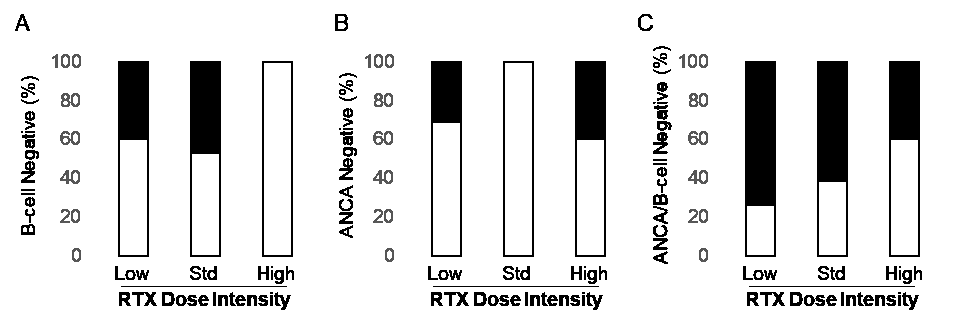Session Information
Session Type: Poster Session A
Session Time: 8:30AM-10:30AM
Background/Purpose: Rituximab (RTX) has demonstrated efficacy in maintenance therapy in ANCA-associated vasculitis. However, different dosing protocols have been used in clinical trials and there is no consensus regarding the optimal regiment. The purpose of this work is to evaluate the variability of RTX dosing in a real-world cohort of ANCA-associated vasculitis patients and the relationship with pharmacological response.
Methods: Patients with a diagnosis of either granulomatosis with polyangiitis (GPA, n=23) or microscopic polyangiitis (MPA, n=5) from a single tertiary care academic medical center were followed prospectively for over 2 years during remission therapy with RTX. All patients met either the 1990 ACR criteria for GPA or the 2012 Chapel Hill Consensus Conference definition for MPA. Dosing of RTX was at the discretion of the treating physician, based on clinical factors and not ANCA titers or B-cell counts. Peripheral blood samples were collected just prior to RTX infusions (i.e. trough of therapy). Demographics, RTX dosing information and laboratory measure of pharmacologic response, including B-cell counts and ANCA titers, were collected throughout the follow-up period. RTX dose intensity was calculated as the RTX dose normalized to dosing interval (mg/d). Stratification of dose intensity was based on a ‘standard’ dosing regimen of 500mg every 5-7 months with others classified as ‘low’ or ‘high’ dosing. Spearman’s rank correlations, unpaired T-tests and Wilcoxon rank-sum testing were used as appropriate.
Results: Mean age at enrollment was 60 ± 14 years, with 68% being female. At baseline, 13 patients were positive for PR3-ANCA, 14 MPO-ANCA and 1 ANCA-negative. The mean dose of RTX infusions was 640 ± 221 mg with a mean interval of 210 ± 88 days. The mean peripheral trough concentration of RTX was 622 ± 548 ng/ml. Peripheral RTX concentrations were significantly associated with dose intensity (p < 0.0001) (figure 1A). Patients with undetectable B-cells had a significantly higher RTX dose intensity compared patients with detectable B-cells (4.1±2.6 vs 2.7±1.2 mg/d, p< 0.0001). Patients with both undetectable B-cells and negative ANCA titers tended to have higher RTX dose intensities (4.4±2.5 vs 2.3±0.5 mg/d, p=0.06). Patients receiving ‘standard’ dosing regimens (2.4-3.3 mg/d, equivalent to 500mg every 5-7 months) had a significantly higher percentage of B-cells compared to higher dose intensities (p=0.0003) (figure 1B). All patients treated with a dose intensity greater than 3.3 mg/d had undetectable B-cells (figure 1C). In the high intensity group 100% of patients had undetectable B-cells versus 69% and 60% for low and standard dosing (p=0.03) (figure 2A). There were no differences in the groups regarding ANCA negativity (figure 2B). While not significant, there was a dose-dependent relationship between dose intensity and the combination of undetectable B-cells and ANCA negativity (p=0.21) (figure 2C).
Conclusion: Standard RTX maintenance dosing intensity of 500 mg every 6 months may be inadequate to maintain B cell depletion in a significant number of patients. A target RTX dose intensity of greater than 3.3 mg/d is required to maintain B-cell depletion.
To cite this abstract in AMA style:
Springer J, Funk R. Pharmacological Response of Rituximab Based on Dose Intensity in Maintenance Therapy of ANCA-Associated Vasculitis [abstract]. Arthritis Rheumatol. 2021; 73 (suppl 9). https://acrabstracts.org/abstract/pharmacological-response-of-rituximab-based-on-dose-intensity-in-maintenance-therapy-of-anca-associated-vasculitis/. Accessed .« Back to ACR Convergence 2021
ACR Meeting Abstracts - https://acrabstracts.org/abstract/pharmacological-response-of-rituximab-based-on-dose-intensity-in-maintenance-therapy-of-anca-associated-vasculitis/


